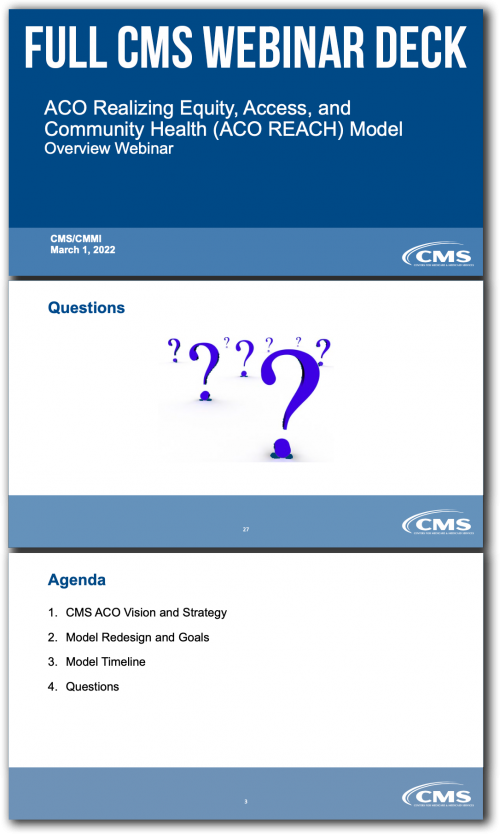Start 14-Day HCC DOC Trial
If you are interested in a trial of our HCC Coding Mobile App, please share your information below and we will respond right away.
CMS Replaces GDCP (DCE) Model With ACO REACH Here’s What Really Changed
CMS recently unveiled a replacement for the Direct Contracting Model, renamed now as the ACO REACH Model. Many of the original Direct Contracting Model tenets will remain the same, with a few significant changes announced.
The stated goals of the overhaul are to advance Equity and expand Access, while continuing with the original aspirations to improve quality and reduce cost.
The Direct Contracting Model received criticism as a move toward privatizing Medicare that would result in “The end of Medicare as we know it.” (This same criticism was leveled against Medicare Advantage.) And while the new ACO REACH model does not answer those concerns directly, it does dial in the focus on societal needs in what could be some very meaningful ways.
The purpose of the Direct Contracting Model was to:
- Empower beneficiaries to personally engage in their own care delivery.
- Transform risk-sharing arrangements in Medicare fee-for-service (FFS).
- Reduce provider burden to meet health care needs effectively.
The new ACO Reach Model sets out to achieve those same aims, while adding:
- Promote health equity and address healthcare disparities for underserved communities
- Continue the momentum of provider-led organizations participating in risk-based models
- Protect beneficiaries and the model with more participant vetting and monitoring and greater transparency
- Prevent over-coding, limit RAF growth, enforce documentation accuracy and reporting.
ACO REACH makes important changes to the GPDC Model in three areas:
Advance Health Equity to Bring the Benefits of Accountable Care to Underserved Communities
- Promotes health equity and focuses on bringing the benefits of accountable care to Medicare beneficiaries in underserved communities
- Implement innovative payment approach to better support care delivery and coordination for patients in underserved communities
- Require that all model participants develop and implement a robust health equity plan to identify underserved communities and implement initiatives to measurably reduce health disparities within their beneficiary populations
Promote Provider Leadership and Governance on ACO board
- Minimum 75% control of ACO’s governing body held by participating providers, up from 25% in the GPDC Model
- Minimum one Medicare beneficiary and one consumer advocate with voting rights
Protect Beneficiaries and the Model with More Participant Vetting, Monitoring, and Transparency.
- Require additional information on ownership, leadership, and governing board
- Increase up-front screening of applicants, robust monitoring of participants, and greater transparency into the model’s progress during implementation
- Share more information on participants and their work to improve care
- Include stronger protections against inappropriate coding and risk score growth
Risk adjustment changes:
Participation Options
There are two voluntary risk-sharing options under the ACO REACH Model. In each option, participating providers accept Medicare claims reductions and agree to receive at least some compensation from their ACO.
- Professional. A lower risk-sharing arrangement—50% savings/losses—with one payment option for participants: Primary Care Capitation Payment, a risk-adjusted monthly payment for primary care services provided by the ACO’s participating providers.
- Global. A higher risk sharing arrangement—100% savings/losses—with two payment options: Primary Care Capitation Payment (described above) or Total Care Capitation Payment, a risk-adjusted monthly payment for all covered services, including specialty care, provided by the ACO’s participating providers.
Previous DCE Risk Adjustment Model
Two policies protect against risk coding growth:
- The ‘Coding Intensity Factor’ (CIF) limits risk score growth across the entire model. The CIF applies to all DCEs to limit risk score growth to the average prior to the start of the model
- A ‘Risk Score Growth Cap’ limits a DCE’s risk score growth to +/- 3% over a 2-year period. The DCE-specific caps on over-coding ensure DCEs are coding appropriately and limit gaming
New ACO Reach Risk Adjustment Model
Two changes to the ‘Risk Score Growth Cap’ further mitigate potential inappropriate risk score gains:
- Adopt a static reference year population for the remainder of the model performance period
- Cap the REACH ACO’s risk score growth relative to the DCE’s demographic risk score growth, so the +/- 3% cap is appropriately adjusted based on demographic changes in the underlying population over time (currently risk score cap is based on HCC growth; this would cap HCC growth relative to demographic growth)
DCE Over-Coding Enforcement
In the prior DCE model a coding intensity factor was applied to limit the growth or the loss of the risk score (RAF). The risk score growth was capped at +/- 3%. This was done to prevent “over coding” according to CMS. In reality many institutions may not have been accurately coding & got better with coding education. Patients would also get sicker & these new diagnoses would add to the risk score.
ACO REACH Limits Risk Score Gains
In the ACO Reach model CMS is attempting to further limit the risk score gains. In the prior model the risk growth took into consideration the RAF increase for HCC codes. But in this new model the growth in RAF relative to HCC growth will further be tied to demographic growth within the entity.
More Changes and Clarifications Coming This Summer
More changes and details are forthcoming this summer, but at present, it looks like the DCE Model has mostly survived, with increased reporting needs around health equity in underserved communities. The exact details of these reporting needs will be released this summer. Follow DoctusTech to keep up to date on the latest news.


